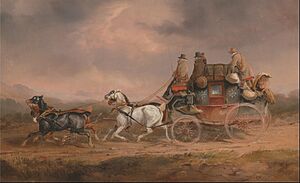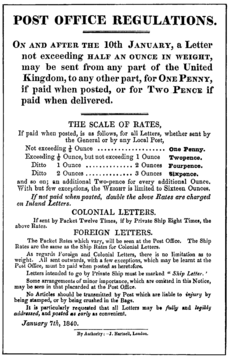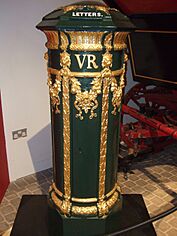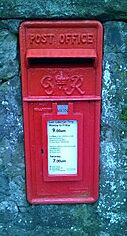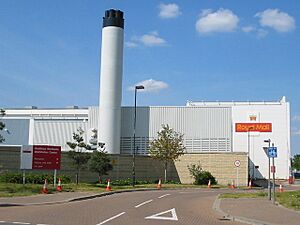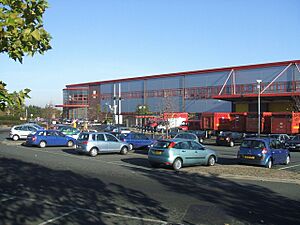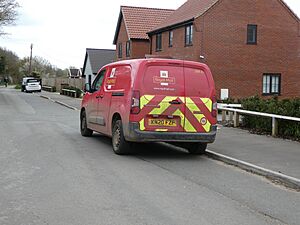Royal Mail facts for kids
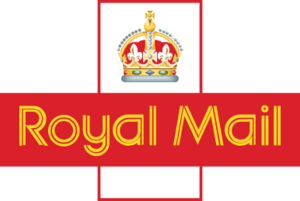 |
|
|
Trade name
|
Royal Mail |
|---|---|
|
Native name
|
Welsh: Post Brenhinol
|
|
Formerly
|
|
| Subsidiary | |
| Industry | |
| Founded | 1516 (Master of Posts) 31 July 1635 (public service) 29 December 1660 (Post Office Act 1660) |
| Founder | Henry VIII |
| Headquarters | London, England |
|
Area served
|
United Kingdom |
|
Key people
|
|
| Services |
|
| Parent | HM Government (1516–2013) International Distribution Services (2013–present) |
| Subsidiaries |
|
Royal Mail Group Limited, known to most people as Royal Mail, is the company that delivers letters and parcels across the United Kingdom. It is owned by a company called International Distribution Services. Royal Mail is one of the oldest postal services in the world.
The company is famous for its red pillar boxes, which were first used in 1852. Many of these post boxes have the initials of the king or queen who was ruling when they were made. Royal Mail delivers mail every day except Sundays and bank holidays. It aims to deliver first-class mail the very next working day.
For most of its long history, Royal Mail was owned by the government. In 2013, it was sold and became a private company. In 2025, it was bought by EP Group, a company based in the Czech Republic. This was the first time Royal Mail was owned by a company from another country.
Contents
A Journey Through Time
The story of Royal Mail begins in 1516. King Henry VIII created a "Master of the Posts" to handle mail for the royal court. The service wasn't for regular people back then.
In 1635, King Charles I opened the postal service to the public. Before this, only the king and his court could use it. Now, anyone could send a letter, but the person who received it had to pay for the postage.
The General Post Office (GPO) was officially created in 1660. Over the next century, the postal network grew. Mail coaches, pulled by horses, began carrying mail across the country. The first mail coach route started in 1784 between Bristol and London.
The Penny Black and Postal Reform
A huge change happened in 1840 thanks to a man named Rowland Hill. He had an idea called the Uniform Penny Post. His idea was simple: the person sending the letter should pay for it, not the person receiving it.
He also suggested that it should cost the same to send a letter anywhere in Britain. This led to the creation of the world's first adhesive postage stamp: the Penny Black. From May 6, 1840, people could buy a stamp for one penny and stick it on their letter to show they had paid. This system was copied by countries all over the world.
Because Britain was the first country to use stamps, its stamps are the only ones that do not have the country's name on them.
Pillar Boxes and New Technology
The first red pillar boxes appeared in 1852. These boxes have the initials of the monarch reigning at the time they were installed. For example, VR stands for Victoria Regina (Queen Victoria) and GR stands for Georgius Rex (King George).
In Scotland, many post boxes made during Queen Elizabeth II's reign are marked with the Crown of Scotland instead of her "EIIR" symbol. This was because of a debate over her title, as Scotland had never had a Queen Elizabeth I.
Over the years, Royal Mail kept up with new technology. It started using mail trains in 1830 and began a telegraph service in 1870. In 1968, it introduced the two-class postal system (first and second class) that is still used today.
Becoming a Modern Company
In 1969, the General Post Office became a government-owned corporation called the Post Office. It was split into different businesses. The part that handled parcels was renamed Parcelforce in 1990.
For a very short time in 2001, the company was called Consignia, but this name was unpopular and was quickly changed back to Royal Mail.
The UK postal market was opened to competition in 2006. This meant other companies could now deliver mail. In 2011, the government passed the Postal Services Act 2011, which allowed for Royal Mail to be sold.
In 2013, Royal Mail was floated on the London Stock Exchange, meaning people could buy shares in the company. The government kept some control, but most of the company became privately owned. In April 2025, the company was sold to EP Group for £3.6 billion.
Royal Mail's Services Today
Royal Mail offers different services for sending letters and parcels.
Universal Service
By law, Royal Mail must provide a "universal service." This means it has to deliver letters of a certain size to any address in the UK for a fixed price, no matter how far it has to travel. This ensures that people in remote areas can send and receive mail for the same price as people in cities.
Special Delivery
For important or urgent items, Royal Mail offers a Special Delivery service. This guarantees that your mail will arrive by 9 a.m. or 1 p.m. the next working day. This service also includes insurance in case the item is lost or damaged.
Business Mail
Most of Royal Mail's work is delivering mail for businesses. Companies can use franking machines or special labels to pay for postage in bulk. This is often cheaper than using regular stamps.
What You Can't Post
Royal Mail has rules about what you can and cannot send in the mail. Items that could be dangerous, like flammable liquids or illegal materials, are prohibited. There is also a list of "restricted" items that can only be posted if certain conditions are met.
How Royal Mail Works
Delivering millions of items every day is a huge task. Royal Mail has a large network of sorting offices, vehicles, and staff to make it happen.
Mail Centres
The backbone of Royal Mail's operation is its network of 37 mail centres. When you post a letter, it is taken to a mail centre. There, machines sort the mail based on its destination.
The sorting process is called Integrated Mail Processing (IMP). Machines scan the postcode on the envelope and print a special orange barcode on it. This code helps other machines sort the letter quickly and accurately.
After being sorted, mail is sent to other mail centres or to one of 1,356 local delivery offices. From the delivery office, a postman or postwoman delivers it to your door.
Royal Mail's Fleet
Royal Mail uses a huge fleet of vehicles to move mail. You have probably seen their red vans and trolleys. For many years, posties used special bicycles made by Pashley Cycles. While many deliveries are now made by van, bicycles are still used on some rural routes.
To move mail over long distances, Royal Mail uses trains and planes. A special air hub at East Midlands Airport handles mail flights. The company has also tested using drones to deliver mail to very remote places, like the Isles of Scilly and islands in Scotland.
Images for kids
See also
 In Spanish: Royal Mail para niños
In Spanish: Royal Mail para niños


